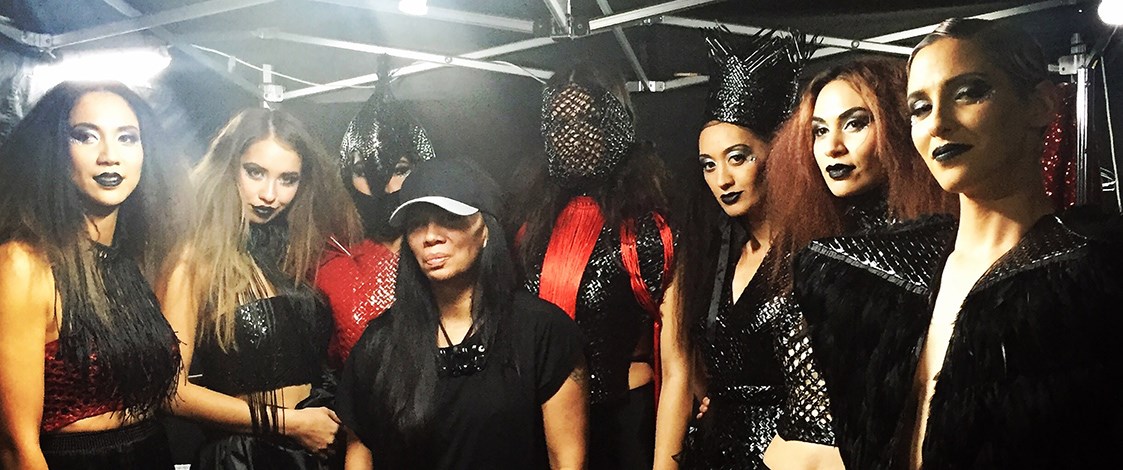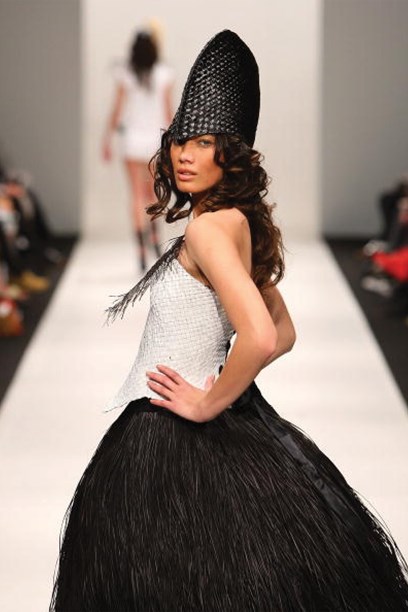Stories
Shona Tawhiao
1970-

Shona Tawhiao has received international acclaim for her creative practice, designing and making contemporary woven garments utilising traditional Māori materials and techniques. Her designs have been worn in movies, Shakespearean plays, on stage by musician and other performers, and they have been shown in fashion shows and museum exhibitions all over the world.
Her work is intimately connected to her identity and she acknowledges that she doesn’t think she’d be doing this mahi if she wasn’t Māori. "Being a Māori artist and designer influences everything I do with my work, life and family."
Shona was born in Murupara in 1970, growing up in a small forestry village, Kaingaroa, just out of Rotorua. She was raised by her grandparents until she was 13, when she moved to Mount Maunganui with her mum, stepdad and younger sister. "Design was always around - my Koro was a talented craftsman. He built playhouses, swings and furniture mainly using wood and he developed large fruit and vegetable gardens. My cousin Tracey Tawhiao is a very well known poet and painter."

Shona Tawhiao with a woven kupenga lace bodice in the background. Image © Shona Tawhiao.
Shona enrolled in Unitec in Auckland after her daughter started kohanga. She hoped to study Māori Art but the only course available was a certificate in Māori Fibre Art. Looking back she says, "I always think mahi raranga found me." Shona studied traditional and contemporary Māori Fibre Methods and Techniques for two years, tutored by the renowned weaver Kahutoi Te Kanawa.
In 1996, Shona founded Takirua Weavers with fellow students Judy Hohaia and Joy Wikitera.They made woven art and kete which were sold at retail outlets all over New Zealand.
Film and television wardrobe departments were also on the lookout for Māori and woven specialty pieces. Word got out and this led to work within the industry. "I knew people at Māori TV who asked me to design and build sets for their shows. I worked on music videos in wardrobe and art departments which was fun because it was much more fast paced." Shona designed costumes for Māori Merchant of Venice, Hercules, Xena, River Queen and What Becomes of the Broken Hearted. "The last film I made pieces for was The Dead Lands. I wove 16 taatua for the main actors - it was quite cool to see them worn on the film posters and on the big screen."
In between film and TV work, Shona continued to design and create new woven pieces. She spent two years working with other weavers to create the back and front walls of the Unitec Marae.
Shona uses traditional materials and techniques, but her designs are contemporary. Some of her garments are made just from harakeke and others are mixed with woven elements or pieces based on traditional korowai pake or piupiu with fabrics and other contemporary materials.
A woven bodice, 2018. Images © Shona Tawhiao.
She describes herself as a weaver first, moving into fashion mainly to create more of a global awareness for mahi raranga and Māori design. "I realised they both work together to create something really unique to Aotearoa and I love the fit between the two."
Shona describes her design process as pretty relaxed. "An idea will pop into my head and I’ll sketch it up or write it down before I forget. I’ve found it easier to design by collection concepts a word or an event once I have a collection name it’s easy to sketch up and then weave." She has a studio in Mount Maunganui and she does a lot of designing and weaving at home.
Her designs often feature warrior themes and motifs. In an interview with New Zealand Herald’s Dan Ahwa (27 July 2016), Shona explained that she finds war, battles and warriors inspiring. "There’s so much significance with war in history and culture. It’s a powerful influence in life for all cultures. What a warrior wears into battle is just as important as the weapons and training."

Shona Tawhiao with a woven kupenga lace bodice in the background. Image © Shona Tawhiao.
In her fashion design Shona’s warriors are women, wahine toa, wearing helmets and breastplates but she has also deployed the signs and symbols of contemporary gangs. For her 2011 collection, Iwi, she printed t- shirt dresses with patches devised to give expression to her tribal and local affiliation, framing the gang patch as a marker of identity.
Shona describes her style of fashion as art in a sculptural and wearable form. Often bold and dramatic her work has regularly won design competitions such as Cult Couture and she has been invited to show her pieces here and internationally. She also makes commissioned pieces, which have been worn by musicians and performers including Ladi6 and Mere Boynton.
Under the label Tawhiao, Shona regularly shows at New Zealand Fashion Week. She has also shown at London and Melbourne Fashion Weeks. In 2016, she added New York to her list, with a three-week residency and exhibition at the Metropolitan Museum’s Oceanic Galleries.

Shona Tawhiao first participated at New Zealand Fashion Week in the Miromoda Show in 2010. Image © Shona Tawhiao.
Shona's 2019 New Zealand Fashion Week show was a joint event with Waiheke Island-based designer, Jeanette Clarkin. Shona's new collection included designs in denim, alongside the harakeke couture she is known for.
Shona's designs have been part of three New Zealand Fashion Museum exhibitions - Black in Fashion: Wearing the colour black in New Zealand, Intellectual Fashion Show 2016 and Moana Currents: Dressing Aotearoa Now.
Text by Kelly Dix. Banner image of Shona Tawhiao backstage at Te Korakora On Federal, Matariki Festival, 2016. Image © Shona Tawhiao.
Published October 2016, updated September 2019.